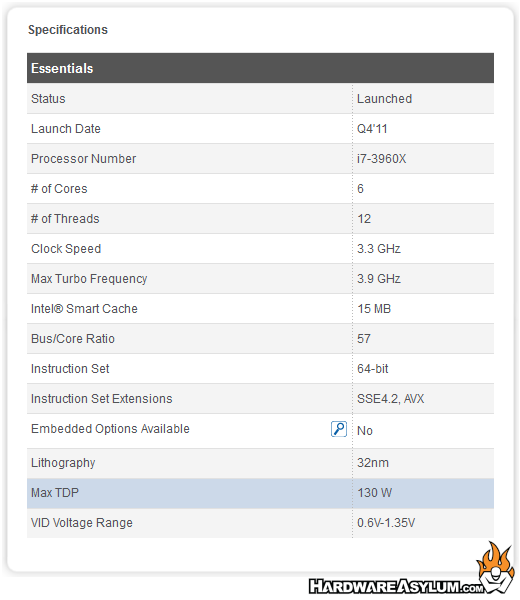bequiet! Dark Rock Pro 3 Heatsink Review
Author: Dennis GarciaBenchmarks
The bequiet! Dark Rock Pro 3 is designed for Intel Socket LGA2011 / 1366 / 1156 / 1155 / 775 and current AMD processors. Here is an overview of the system and testing methodology.
Asus P9X79 - X79 Chipset
Intel Core i7 3960x (3.3Ghz) Hex Core 6 x 256KB L2 Cache 15MB L3 Cache
bequiet! Dark Rock Pro 3
bequiet! Shadow Rock 2
The CPUID System Monitor was used to obtain and record system temperature data and being that this is a quad core processor we need something that will work across all of the cores at once. For this task we're using a new version of Prime95 (p95v255a) that will allow you to spawn (n) instances to test with.

Editors note: Even though the Windows 7 task manager reported 100% processor usage we could never attain a 100% of the rated heat output as documented by Intel (see below) when using Prime95 as a basis for that heat production. Knowing this we ran the stress test until the maximum temperature was attainted and stabilized.
Other things to consider when judging software induced heat output.
a) Clock throttling by the processor at high temperatures.
b) Normal software isn't designed to produce maximum heat output.
c) Variances of cooling temperature.
d) Variances in CPU load.
e) Inaccuracies in thermal diode readouts.
Of course the list goes on..
Our testing methodology is aimed to provide a real world look into this heatsink given the test system provided.

A C/W rating can quickly be calculated using this formula.
C/W = (CPU temp - Ambient temp)/(Variance(%) * CPU Watts)
Allowed variance for this test = 85%
CPU Watts = 130W
0.20C/W = (46C - 24C)/(.85(130W))
For this next test the CPU speed was cranked up to 4.4Ghz and the test was re-run

To calculate a new C/W rating for this test we will need to factor in the increased processor wattage. The formula and constants for this are listed below.
ocC/W = dCPU Watts * (ocMhz / dMhz) * (ocVcore / dVcore)2
ocMhz = 4400
dMhz = 3300
ocVcore = 1.325
dVcore = 1.2
The variance still applies for our C/W calculation
Allowed variance for this test = 85%
CPU Watts = 211W
0.22 C/W = (64C - 24C)/(.85(211W))
In our heatsink and waterblock tests we don't really focus on overall load temperatures but rather how well the product can remove heat given a specified heat load. Since this is a real world testing method we need to take into consideration real world variables and estimate tolerances. This is why we normally only apply 85% of the total wattage output to our heat calculations.
The resulting C/W number is used to rate how efficient a heatsink or waterblock is based on the given heat load. These numbers can be used to determine heat capacity, the larger the difference the less efficient the heatsink is. (aka not good for overclocking)
Most lower-end heatsinks have a rather pronounced variance between the default and overclocked temps which is sometimes good and sometimes bad. For these tests you'll see that the resulting C/W numbers did increase between the default and overclocked tests. This is indicating that we have started to reach the thermal limit of the cooler.
One thing make note of is that while our C/W numbers remained close the recorded CPU temp was a little higher than what we would want under an overclocking condition. Given that bequiet! coolers are designed for silence the trade off is that flat out overclocking will be limited but under normal usage you can run quiet with higher ambient temps than you normally would.
Keep in mind these calculations are provided for demonstration purposes only and may not reflect the actual lab tested C/W rating, but we're pretty close.

